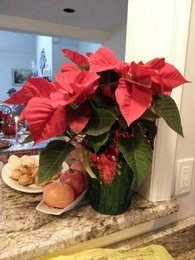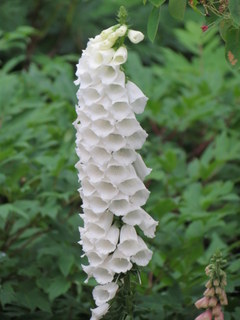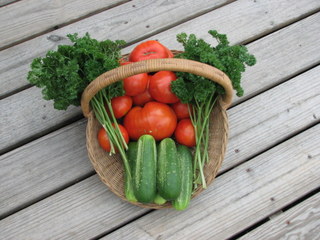Welcome to Garden Spikes
Timely Garden Tips
Timely Garden Tips
Enjoy the cooler weather and prepare for the Christmas and New Year holiday season. Garden centers have large displays of Poinsettias. Place several Poinsettias around your home to brighten it.
General: After the leaves have been raked or mowed from your lawn and put into your leaf mulch pile it is time to get your gutters cleaned.
Do a soil test of the pH before the ground freezes. If you need to lower the pH you will need to add some garden sulfur. To raise the pH, you will need to add some lime. It will take some time for the amendments to work, so the best time to do it is in the fall before the ground freezes. In either case read and follow the product instructions on the package. There is no need to add any fertilizer at this time of the year when growth has slowed or stopped.
Flowers: After the hard frost kills the foliage of your perennials cut them off 3 to 4-inches from the ground and put in the trash to reduce the occurrence of diseases and pests.
For newly planted perennials put a small stake to mark the location and place a small mound of mulch, such as shredded leaves or pine straw over the plant and cover with a piece of burlap or carpet. Use some branches or rocks to keep the wind from blowing the mulch away. In the late winter as the days warm up, remove the burlap or carpet and some of the mulch to allow the new growth to emerge as the ground warms up.
Were some of your flower plants leaning in one direction because they need more sunlight? Place a marker at the base of the plant so that you will remember to move it to a better location in the late winter or early spring after the ground has thawed. Make a note in your garden journal.
Seeds of English daisies, forget-me-nots, coneflower, black-eyed Susan, foxglove and other annuals or perennials that naturally self-sow may still be seeded now.
Tender perennials such as begonias, caladium, calla lily, canna, dahlias, elephant ear, etc. should be dug up and stored over winter in a cool, dry location after the foliage has died down.
Vegetables: Harvest any remaining vegetables before the frost hits them. Clean up the fallen fruit, dead plants and vines completely, to have fewer diseases and pests next year. Some mold spores, diseases and insects can over winter in the plant remains. Put in the trash not the compost pile.
Using gloves, cut to the ground raspberry canes that have fruited.
Late fall is a transition time between the end of gardening and preparing for winter. Take time to note the successes and failures.
Houseplants: Inspect your houseplants regularly for pests.
Timely Quote:
“December is a month of lights, snow and feasts; time to make amends and tie loose ends; finish off what you started and hope your wishes come true.” - Unknown
Successful gardeners use the principle of working with nature to practice the easy, economical and environmental methods that can make gardening relaxing and rewarding.
Flowers that grow on spikes are a favorite among many gardeners. Coleus, foxglove, gladiolus, hyacinth, lavender, obedient plant, orchid and salvia are some common flowers that grow on spikes.
Are You a Gardener?
Many people do not think of themselves as gardeners. If you have a lawn, a few houseplants or grow some flowers and vegetables, you are a gardener.
It can range from beautifying your home to providing wholesome organic food for your family.
Gardening Can Be Easy and Relaxing
You might have just a few houseplants in containers on a window, patio or deck.
If you have more space it might be a small flower bed or a larger area to attract butterflies, hummingbirds and honey bees.
Some will concentrate on roses of every color and type. Others search for as many different varieties of flowers that they can find.
If you have a sunny location it could also be a few tomato plants in containers or a large area for vegetables and herbs that will feed the entire family with enough to preserve for the winter.
Keep It Simple
If you are new to gardening the secret is to keep it easy and start small. Each year you can expand your garden a little more. Your native soil may be very sandy or it may be heavy clay with a lot of rocks. For plants to grow properly you will need good garden soil by adding organic material to the native soil.
One year you may plant some flowers or shrubs along the front of your home. The next year add a flower bed along the driveway. And the year after that a flower bed around your mailbox or the tree in the front yard.
A vegetable garden works the same way. Plant what your family likes to eat. You may start with 100-square feet and plant half of it with tomatoes and the rest with lettuce, Swiss chard, parsley, dill and basil. These will supply you with fresh vegetables and herbs continuously during the summer.
Next year as you improve the soil you can expand your vegetable garden to include peas, beans, carrots, beets, zucchini, cucumbers, etc. By growing your own food you can be assured that your food is truly organic and free of pesticides.
It does not have to be a big project if you break it down into smaller easy to do steps. If you spend 10 or 15-minutes each day or every other day it never gets ahead of you.
Environment
Composting your yard and kitchen waste is also one small step. Composting is environmentally friendly and you will keep from adding to the landfills. Adding finished compost will also improve your soil and fertilize it at the same time. It is nature’s way of recycling.
Mulching around your plants with leaves collected in the fall will improve the soil and at the same time make your flower garden and vegetable garden almost entirely weed free.
Gardening Thought
“Earth is here so kind
That just tickle her
With a hoe and she
Laughs with a harvest”
- Douglas William Jerrold (1803-1857)
Garden Spikes newsletters give you timely information once or twice a month. Subscribe Free to the Garden Times newsletter below.
Your email address will only be used to send you a newsletter and will never be sold. You can unsubscribe at any time.



